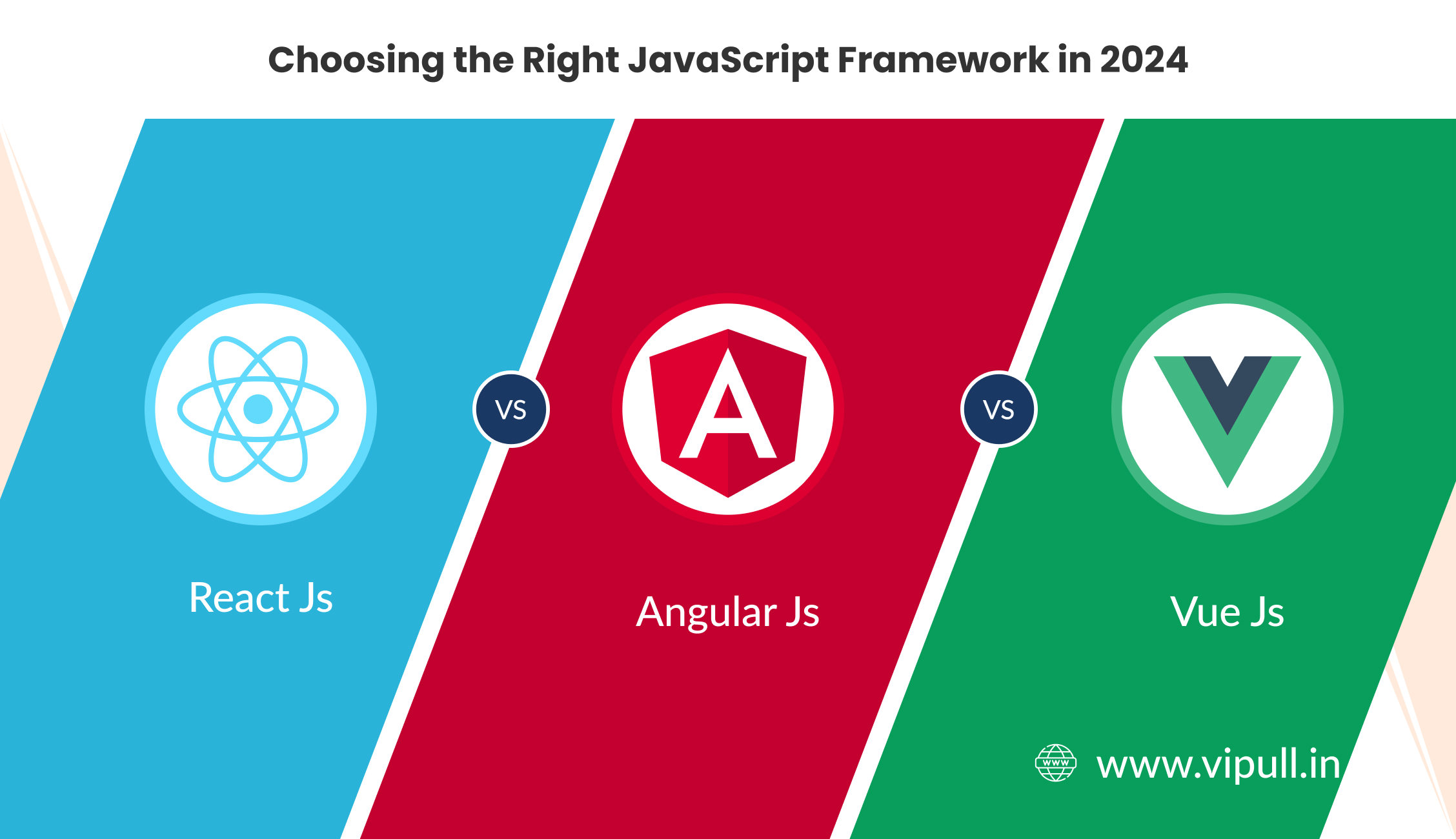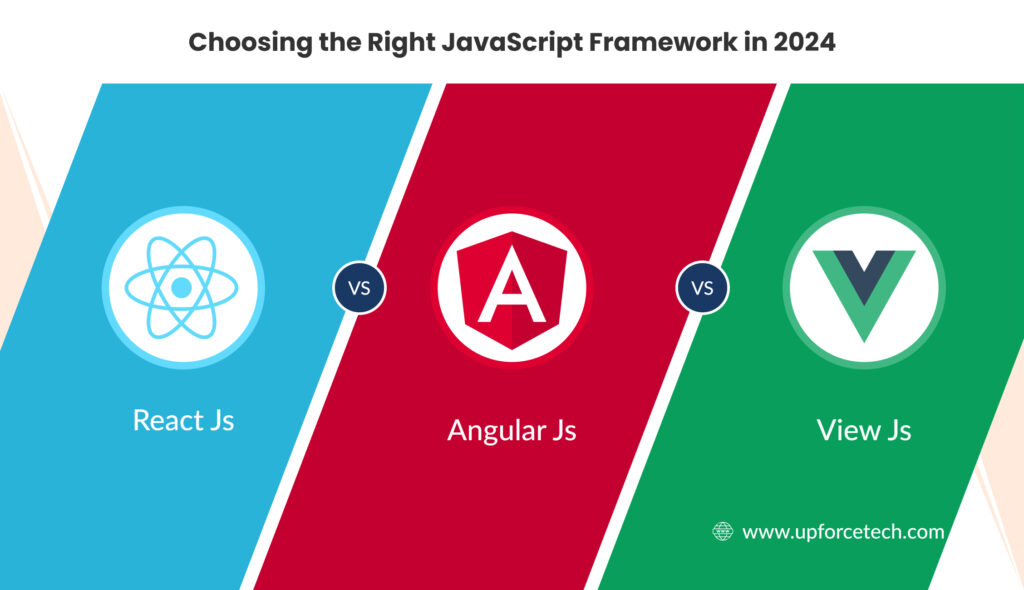Table of Contents
Choosing the Right JavaScript Framework in 2024:
React vs. Angular vs. Vue

Choosing the right JavaScript framework is crucial for any web development project. With several powerful frameworks available, selecting the best one can significantly impact your project’s success. In 2024, React.js, Angular.js, and Vue.js continue to be the most popular and robust frameworks. This blog will provide a comprehensive comparison of these three frameworks, helping you make an informed decision for your development needs. We’ll explore their features, pros and cons, use cases, and performance to determine the best fit for your project.
The Importance of Choosing the Right Framework
Selecting the right JavaScript framework is essential for various reasons:
- Performance: Ensuring your application runs smoothly and efficiently.
- Scalability: Allowing your project to grow and handle more users and data.
- Development Speed: Streamlining the development process with pre-built components and tools.
- Maintainability: Facilitating easy updates and maintenance over time.
- Community Support: Providing access to resources, plugins, and solutions to common problems.
Overview of React.js, Angular.js, and Vue.js
React.js
React.js, developed and maintained by Facebook, is a library for building user interfaces. It uses a component-based architecture, enabling developers to create reusable UI components.
Angular.js
Angular.js, developed by Google, is a comprehensive framework for building dynamic web applications. It provides a robust set of tools and features, making it ideal for large-scale enterprise applications.
Vue.js
Vue.js is a progressive framework known for its simplicity and flexibility. It can be used for both small-scale and large-scale applications, making it a versatile choice for developers.
| Feature | React.js | Angular.js | Vue.js |
|---|---|---|---|
| 1. Virtual DOM | Yes | No (uses Real DOM) | Yes |
| 2. Component-based architecture | Yes | Yes | Yes |
| 3. JSX syntax | Yes | No | No |
| 4. Two-way data binding | No | Yes | No |
| 5. Dependency injection | No | Yes | No |
| 6. TypeScript support | Optional | Yes | Yes |
| 7. Comprehensive testing tools | Yes (Jest, Enzyme, React Testing Library) | Yes (Jasmine, Karma, Protractor) | Yes (Jest, Vue Test Utils) |
| 8. CLI for project management | No | Yes | Yes (Vue CLI) |
| 9. Built-in support | No | Yes (HTTP, routing, form validation) | No |
| 10. State management | Redux, Context API | Built-in services (NGRX for state) | Vuex |
| 11. Reactive data binding | No | No | Yes |
| 12. Flexibility | High | Moderate | High |
| 13. Documentation | Extensive | Comprehensive | Detailed |
| 14. Community and ecosystem | Strong | Strong | Growing |
| 15. Integration | Can be integrated with other libraries easily | Built-in support for many features | Easy integration with other projects and libraries |
Pros and Cons
| Criteria | React.js | Angular.js | Vue.js |
|---|---|---|---|
| Pros | – High performance with Virtual DOM | – Strong structure and conventions | – Easy to learn and integrate |
| – Reusable components enhance maintainability | – Extensive built-in features and tools | – Flexible, can be used incrementally | |
| – Rich ecosystem with numerous libraries and tools | – High performance and scalability | – Active community and excellent documentation | |
| – Strong community support | – Comprehensive documentation and testing support | – Simple and intuitive syntax | |
| Cons | – Steeper learning curve for beginners | – Steep learning curve | – Smaller ecosystem compared to React and Angular |
| – Requires additional libraries for state management and routing | – Heavier framework compared to React and Vue.js | – Limited support for large-scale enterprise applications |
Performance Comparison
| Criteria | React.js | Angular.js | Vue.js |
|---|---|---|---|
| Initial Load Time | Fast | Moderate | Fast |
| Update Speed | Fast (Virtual DOM) | Fast | Fast (Virtual DOM) |
| Bundle Size | Smaller | Larger | Smaller |
| Memory Consumption | Low | Moderate | Low |
| Rendering Performance | High | High | High |
| Overall Performance | Excellent for high interactivity and real-time updates | Excellent for complex, large-scale applications | Excellent for both small and large projects |
Use Cases
| Framework | Use Cases | Project Examples |
|---|---|---|
| React.js | – Single-page applications (SPAs) | – Facebook, Instagram, Netflix |
| – Mobile applications (using React Native) | ||
| – Interactive user interfaces | ||
| – Real-time data applications | ||
| Angular.js | – Enterprise-level applications | – Google AdWords, Microsoft Office 365 |
| – Single-page applications (SPAs) | ||
| – Progressive web apps (PWAs) | ||
| – Complex web applications with multiple features | ||
| Vue.js | – Single-page applications (SPAs) | – Alibaba, Xiaomi, 9GAG |
| – Progressive web apps (PWAs) | ||
| – Prototypes and small-scale projects | ||
| – Integration into existing projects |
Detailed Comparison: React.js vs. Angular.js vs. Vue.js
Learning Curve and Ease of Use
- React.js: React has a moderate learning curve, especially with its use of JSX and the need for understanding state management. However, once mastered, it offers great flexibility and power.
- Angular.js: Angular has a steep learning curve due to its comprehensive nature and use of TypeScript. It requires understanding of concepts like dependency injection and decorators.
- Vue.js: Vue has the gentlest learning curve, with a simple and intuitive syntax. It’s easy to integrate into existing projects and can be incrementally adopted.
Development Speed and Productivity
- React.js: React’s component-based architecture and reusable components enhance productivity. Its ecosystem provides various tools for rapid development.
- Angular.js: Angular’s strong conventions and built-in tools like CLI and dependency injection improve productivity for large-scale projects.
- Vue.js: Vue’s simplicity and flexibility enable fast development. Its Vue CLI and ecosystem tools facilitate efficient project setup and management.
Scalability
- React.js: React scales well for large applications, especially with state management solutions like Redux. Its component-based architecture supports modular development.
- Angular.js: Angular is designed for scalability, with features like lazy loading, hierarchical dependency injection, and strong typing through TypeScript.
- Vue.js: Vue can handle both small and large projects. However, for very large applications, additional planning and architecture considerations may be needed.
Community and Ecosystem
- React.js: React has a vast and active community, providing numerous libraries, tools, and resources. It benefits from extensive third-party support and regular updates.
- Angular.js: Angular has a strong community and is backed by Google. Its ecosystem includes various tools for testing, building, and deploying applications.
- Vue.js: Vue’s community is growing rapidly, with active support and contributions. Its ecosystem includes tools like Vuex for state management and Vue Router for routing.
Case Studies: Real-World Applications
React.js Case Study: Facebook
- Project Requirements: High interactivity, real-time updates, and scalability.
- Solution: Facebook uses React to handle dynamic and interactive user interfaces, benefiting from its virtual DOM and component-based architecture.
- Outcome: Enhanced user experience with fast, responsive interfaces and efficient rendering.
Angular.js Case Study: Google AdWords
- Project Requirements: Complex functionality, high performance, and scalability.
- Solution: Google AdWords uses Angular to manage its intricate data and operations, leveraging Angular’s robust architecture and built-in tools.
- Outcome: Improved performance, maintainability, and scalability for a large-scale application.
Vue.js Case Study: Alibaba
- Project Requirements: Fast development, high performance, and integration with existing projects.
- Solution: Alibaba uses Vue.js for its simplicity and flexibility, allowing rapid development and efficient performance.
- Outcome: Streamlined development process, enhanced user experience, and smooth integration.
Choosing the Right Framework for Your Project
Factors to Consider
- Project Requirements: Assess the specific needs of your project, including complexity, performance, and scalability.
- Team Expertise: Consider the experience and skill level of your development team with each framework.
- Community Support: Evaluate the community support, documentation, and available resources for each framework.
- Long-Term Maintenance: Choose a framework that aligns with your long-term maintenance and scalability goals.
- Performance: Assess the performance benchmarks and optimization capabilities of each framework.
- Ecosystem: Consider the availability of third-party libraries, plugins, and tools that can enhance your development process.
Detailed Comparison Table: React.js vs. Angular.js vs. Vue.js
| Criteria | React.js | Angular.js | Vue.js |
|---|---|---|---|
| Developed By | Evan You | ||
| Initial Release | 2013 | 2010 | 2014 |
| Current Version (as of 2024) | 18.x | 14.x | 3.x |
| Language | JavaScript, JSX | TypeScript | JavaScript, TypeScript |
| Architecture | Component-based | Component-based, MVC | Component-based, MVVM |
| Data Binding | One-way | Two-way | Two-way |
| DOM | Virtual DOM | Real DOM | Virtual DOM |
| Performance | High, optimized with Virtual DOM | High, but heavier due to Real DOM | High, optimized with Virtual DOM |
| Learning Curve | Moderate | Steep | Easy |
| Community Support | Very Strong | Strong | Growing Rapidly |
| Development Speed | High, with reusable components | High, with CLI and comprehensive tools | High, with simplicity and Vue CLI |
| Scalability | High, excellent for large applications | Very High, designed for large-scale applications | Moderate to High, suitable for various projects |
| State Management | Redux, Context API, MobX | Built-in services, NGRX | Vuex |
| Routing | React Router | Angular Router | Vue Router |
| Testing Tools | Jest, Enzyme, React Testing Library | Jasmine, Karma, Protractor | Vue Test Utils, Jest |
| Use Cases | SPAs, Mobile Apps, Interactive UIs | Enterprise Apps, SPAs, PWAs | SPAs, PWAs, Prototypes |
| Popularity | Extremely Popular | Popular | Increasing Popularity |
| Best For | Dynamic and interactive UIs | Complex and large-scale enterprise applications | Flexible and fast development |
| Pros | High performance, reusable components, strong community support | Strong structure, built-in tools, TypeScript support | Easy to learn, flexible, simple syntax |
| Cons | Steeper learning curve, requires additional libraries | Steep learning curve, heavier framework | Smaller ecosystem, limited for very large projects |
Decision Matrix
| Criteria | React.js | Angular.js | Vue.js |
|---|---|---|---|
| Learning Curve | Moderate | Steep | Easy |
| Development Speed | High | High | High |
| Scalability | High | Very High | Moderate to High |
| Community Support | Very Strong | Strong | Growing Rapidly |
| Performance | High | High | High |
| Ecosystem | Extensive | Extensive | Growing |
| Use Cases | SPAs, Mobile Apps, UIs | Enterprise Apps, SPAs, PWAs | SPAs, PWAs, Prototypes |
Popular Use Cases and Project Examples
| Framework | Popular Use Cases | Project Examples |
|---|---|---|
| React.js | – SPAs, Mobile Apps (React Native), Interactive UIs | – Facebook, Instagram, Netflix |
| Angular.js | – Enterprise-level Applications, SPAs, PWAs | – Google AdWords, Microsoft Office 365 |
| Vue.js | – SPAs, PWAs, Prototypes, Incremental Integration Projects | – Alibaba, Xiaomi, 9GAG |
Key Performance Indicators
| Performance Indicator | React.js | Angular.js | Vue.js |
|---|---|---|---|
| Initial Load Time | Fast | Moderate | Fast |
| Update Speed | Fast (Virtual DOM) | Fast | Fast (Virtual DOM) |
| Bundle Size | Smaller | Larger | Smaller |
| Memory Consumption | Low | Moderate | Low |
| Rendering Performance | High | High | High |
Future Trends and Updates
| Framework | Future Trends | Expected Updates in 2024 |
|---|---|---|
| React.js | Continued focus on concurrent rendering and server components | Improved performance, new hooks, better server-side rendering |
| Angular.js | Enhanced tooling and integration with cloud-native solutions | Updates to CLI, improved TypeScript support, enhanced Ivy rendering engine |
| Vue.js | Growing adoption in enterprise-level applications | Improved Vuex and Router, better TypeScript integration, more robust DevTools |
Conclusion
Choosing the right JavaScript framework in 2024 requires a thorough understanding of your project’s needs, team expertise, and long-term goals. React.js, Angular.js, and Vue.js each offer unique strengths and cater to different use cases. By carefully evaluating the features, pros and cons, and performance of each framework, you can make an informed decision that enhances your development process and delivers exceptional user experiences.
For expert guidance on selecting and implementing JavaScript frameworks tailored to your business needs, contact UpforceTech. Our team specializes in delivering cutting-edge web development solutions that leverage the power of modern frameworks to create scalable, high-performance applications.
Ready to choose the perfect JavaScript framework for your next project? Let UpforceTech help you make the best decision and bring your vision to life with cutting-edge web development solutions. Contact us today to get started!
Sign up for the free Newsletter
"Choosing the right JavaScript framework is like laying the foundation for your project—make the right choice, and everything else will fall into place."
UpforceTech
FAQs
Consider project requirements, team expertise, community support, long-term maintenance, performance, and the ecosystem of third-party libraries and tools.
React is a library focused on building user interfaces with a component-based architecture, while Angular is a comprehensive framework that offers a complete solution for building dynamic web applications.
Vue.js is popular due to its simplicity, flexibility, and ease of integration. It allows developers to gradually adopt its features and build applications incrementally.
React.js is often recommended for beginners due to its simpler syntax (with JSX) and a large community that provides ample learning resources.
Yes, migration is possible, but it can be complex depending on the size and structure of your project. Tools and guides are available for migration between these frameworks.
Angular.js is well-suited for large-scale applications due to its comprehensive features like dependency injection and built-in support for various functionalities such as HTTP requests and form validation.
Yes, each framework has its performance characteristics. React.js and Vue.js utilize Virtual DOM, which can optimize rendering performance. Angular.js offers extensive features but can be heavier due to its reliance on Real DOM.
Community support is crucial for learning, troubleshooting, and keeping up with updates. React.js and Vue.js have strong and growing communities, while Angular.js benefits from Google's backing and extensive documentation.
React.js is ideal for single-page applications (SPAs) and dynamic user interfaces. Angular.js is favored for enterprise-level applications and progressive web apps (PWAs). Vue.js is flexible and suitable for both small prototypes and larger applications.
While not mandatory, Angular.js and Vue.js offer native support for TypeScript, enhancing type safety and developer productivity. React.js supports TypeScript but does not require it for development.

